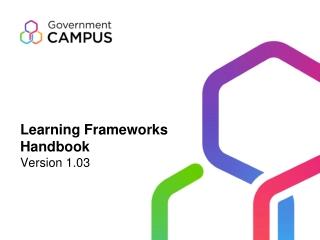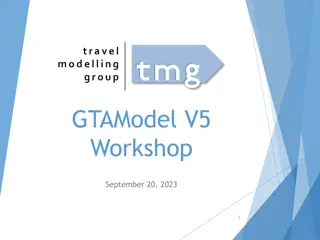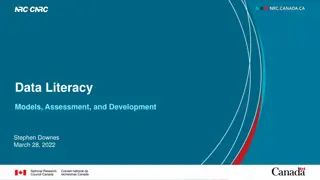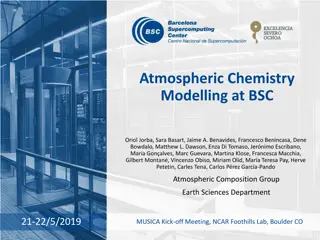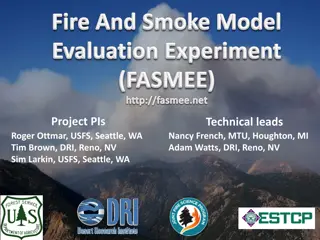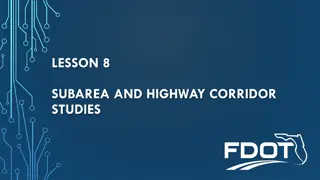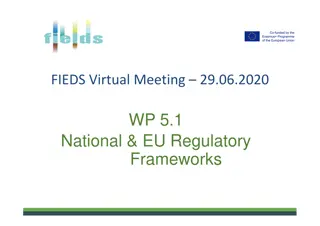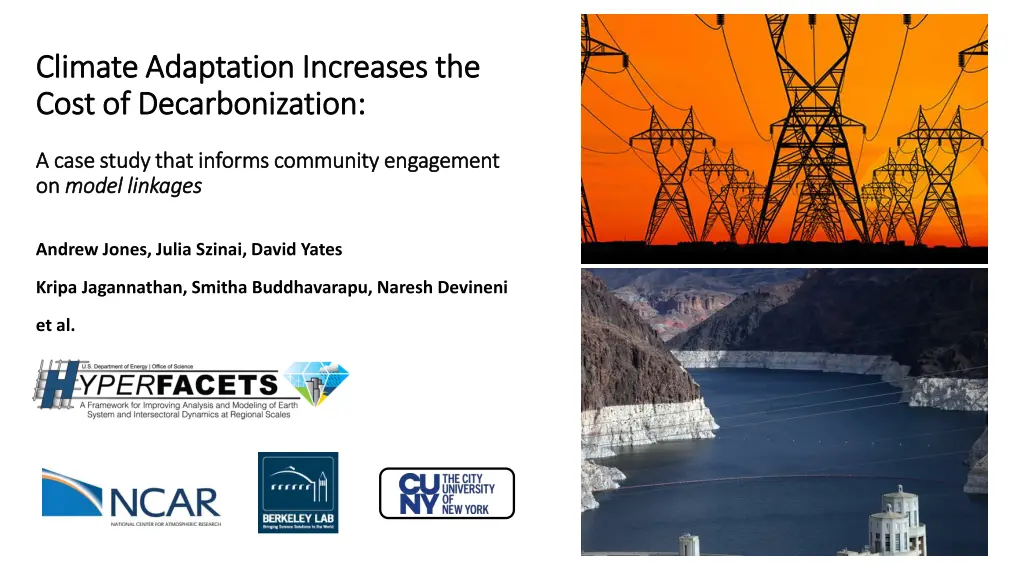
Energy-Water Nexus Connections and Climate Adaptation Cost Study
Explore the interconnections between energy, water resources, and climate adaptation costs through a comprehensive case study and community engagement model linkages analysis.
Download Presentation

Please find below an Image/Link to download the presentation.
The content on the website is provided AS IS for your information and personal use only. It may not be sold, licensed, or shared on other websites without obtaining consent from the author. If you encounter any issues during the download, it is possible that the publisher has removed the file from their server.
You are allowed to download the files provided on this website for personal or commercial use, subject to the condition that they are used lawfully. All files are the property of their respective owners.
The content on the website is provided AS IS for your information and personal use only. It may not be sold, licensed, or shared on other websites without obtaining consent from the author.
E N D
Presentation Transcript
Energy-Water Nexus Connections (U.S. DOE, Energy Demands on Water Resources, Report to Congress on the Interdependency of Energy and Water, 2006.) Climate Adaptation Increases the Climate Adaptation Increases the Cost of Decarbonization: Cost of Decarbonization: A case study that informs community engagement A case study that informs community engagement on on model linkages model linkages Andrew Jones, Julia Szinai, David Yates Lake Folsom, Jan. 2014 drought, Source: CA Dept. of Water Resources Kripa Jagannathan, Smitha Buddhavarapu, Naresh Devineni et al. How do water system interdependencies affect electricity system resilience under climate change?
HyperFACETS Cross-Cutting Engagement Themes appropriate use of datasets, (d) Analyzing interacting timescales and trends, (e) Assessing antecedent conditions, (f) Guidance on model hierarchies, (g) Aridification, (h) Groundwater assessments and (i) Analyzing drivers and processes. The facilitators undertook a clustering exercise to collate similar questions or ideas. The clustering exercise resulted in nine research themes that the groups of practitioners and scientists identified as important to the broader community: (a) Examining no-analog futures, (b) Approaches to developing probabilistic storylines, (c) Model credibility and guidance on Participants were then asked to undertake a prioritization exercise to choose the most valuable topics out of these. Each participant was given three votes for the topics that they found most important and relevant to pursue in V3. The facilitators then counted the votes and identified the top three topics with the most votes. These were: (a) Approaches to developing probabilistic storylines, (b) Guidance on Model Hierarchies and (c) Model credibility and guidance on appropriate use of datasets. These three topical areas were further discussed in three concurrent breakout groups wherein the participants formulated some initial research questions, explored possible approaches/methods for conducting the research, and discussed the potential impact of their research for both practitioners and scientists. The breakout discussions for each of the topics are summarized below. Guidance on use of model hierarchies / linkages Approach to Probabilistic Storylines One important research area that repeatedly came up both in the workshop and in earlier scientist-practitioner discussions was whether it would be possible to assign probabilities to storyline line based results, and if yes what would be a sound approach to do so. The motivation for the interest in this topic was that the storyline approach can only examine how future climate change may affect the characteristics and dynamics of a specific event. But the nature of the methodological approach (and simulation) is such that it cannot provide information on how often such an event is likely to happen in the future. Therefore the storyline analysis alone may
What are model hierarchies? The linkage of climate models and data with impact/management models to assess the impacts of climate change on human systems. Since we are not talking about actual hierarchies, we might want to rename the title to model linkages? What is the goal of this work? Use HyperFACETS and other examples to co-produce a common set of challenges and guidance for addressing climate and impact model and data linkages
Synthesis of working group discussions to-date Different flavors of models and data: Climate model hierarchy: global models, regional models, regional refined global models, ML models driven by global/regional models Process-based ML models vs. statistical models Climate models connected with impact models Different ways to evaluate credibility of different models: Better skill differs based on type of model, intended use or question to be answered, variable (extremes vs. average, application, location) One type of model (e.g. ML) can diagnose the behaviors of another type Challenges: Temporal and spatial mismatch among models in hierarchy Error propagation and uncertainties across model hierarchies Communication of model outcomes and uncertainties
Literature review Practitioner Survey Scientist Survey Proposed project approach Survey of practitioners separately on their experiences working with model hierarchies Survey of scientists separately on their experiences working with model hierarchies Synthesis from different literatures of challenges and solutions for model hierarchies Facilitated dialogue and synthesis Discussion on agreement and gaps on findings, possibly including experts from MultiSector Dynamics CoP Case studies Apply and test guidance with in-house or stakeholder model hierarchies Co-produced guidance Recommendations on best practices and stakeholder- relevant guidance on model/data linkages
Survey question themes 1. Details of climate models and observation data use 2. Challenges of integrating climate data into impact models 3. Tools or techniques used to overcome integration challenges 4. Uncertainty & Error Propagation For what applications/resear ch questions are you using climate model data? What data do you use, how is it used, how do you access it, how do you choose it, downscale it? Observational vs. climate model data and formats? Overall challenges in integration? How do extreme events affect modeling choices? Do you have any spatial and temporal mismatch challenges Computational challenges? What solutions do you use to address integration challenges? Do you adjust for extreme events? How do you resolve spatial/temporal mismatches? How do you overcome computational challenges? How do you assess and communicate error propagation and uncertainty given challenges? Do you separate how you consider and communicate uncertainty from climate model data versus impact model data?
Case Studies Climate Data Hydrology Models Drought-induced Water Stress Evaporative Demand Streamflow Reservoir Rule Curves (Operating Policy) Reservoir Storages Reservoir Releases Water Demands Reservoir Models Water Supply Risk Metrics Water Policy The Cannonsville, Pepacton and Neversink reservoirs provide up to 50% of the water to NYC and serve downstream ecosystem
Climate Data Case Studies UrbanFlood Scenarios Outcomes will be useful in planning for storm emergencies and improving the design/analysis of infrastructure Extreme Rainfall Simulations IDF Creation SWMM HEC-RAS
Case Studies Water and energy system transformation to achieve decarbonization and resilience 9 Source: U.S. Dept. of Energy, Energy Demands on Water Resources, Report to Congress on the Interdependency of Energy and Water, 2006.
Electricity demand increases to varying degrees across all climate scenarios Hydropower supply is more variable Supply and demand imbalances tend to concentrate in summer months, compounding one another.
Additional capacity for adaptation can be substantial Up to 139GW, which is 3X current peak demand in CA Costs of adaptation vary significantly across climate scenarios
Learn more: Szinai J.K., D. Yates, P. A. S nchez-P rez, M. Staadecker, D. M. Kammen, A. D. Jones, P. Hidalgo-Gonzalez (in review). Climate change and its influence on water systems increases the cost of electricity system decarbonization. Nature Communications Yates, D., J. Szinai, A.D. Jones (2024). Modeling the Water Systems of the Western US to Support Climate-Resilient Electricity System Planning. Earth s Future. https://doi.org/10.1029/2022EF003220 Buddhavarapu, S., K. Jagannathan, A.D. Jones (2023). HyperFACETS 2023 Workshop: Summary Report.

